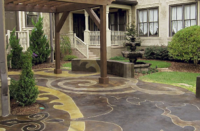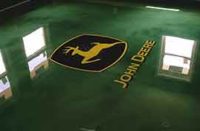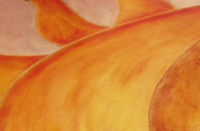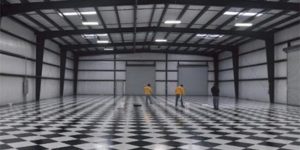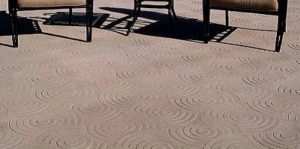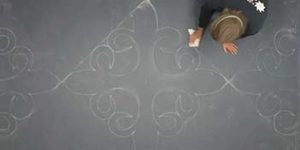 All work and no play makes for some very dull concrete, says Brian Vicari, owner of the Concrete Colorist in Benicia, Calif., about 35 miles northeast of San Francisco. Not to mention, it also usually results in an overworked, unsatisfied contractor.
All work and no play makes for some very dull concrete, says Brian Vicari, owner of the Concrete Colorist in Benicia, Calif., about 35 miles northeast of San Francisco. Not to mention, it also usually results in an overworked, unsatisfied contractor.
“You’ve got to dedicate time to play with the material by yourself, with the guys and in the studio,” he says. “That’s an important part of the process. You’ve got to have time to play if you’re going to be happy with your work.”
 Vicari says he really gets fired up about the possibilities of concrete when he’s sampling and building mockups in his studio. “That’s where the fun stuff happens; that’s where you learn to push.”
Vicari says he really gets fired up about the possibilities of concrete when he’s sampling and building mockups in his studio. “That’s where the fun stuff happens; that’s where you learn to push.”
For the past five years, he’s been pushing the liquid stone to create abstract concrete paintings. Initially, he says, the paintings were his own personal creative outlet, but family and friends have encouraged him to start offering his wares for sale. “Most of the paintings are done with overlays by troweling on different layers of integral colors and then using stains and dye washes,” he explains. And contrary to what you may think when you see one, “It’s all done with a trowel. There’s no brush involved.”
The paintings — which range from 2 feet by 2 feet to 4 feet by 4 feet — are made to be interior hangings. “They allow me to push what we can do with concrete in a limited area. My clients may not want this type of visual color on their floor but they can appreciate it on the wall,” Vicari says. “It allows the public to see what can be done with concrete and to appreciate concrete as fine art.” Because after all, concrete can be much, much more than just an ordinary floor, he adds.

Getting started
Vicari, 31, first started “playing with acid stain in a basement” right out of college, when he was running an office in Boulder, Colo., for a company that dealt with hardwood floors. Before he knew it, he was running a few crews that stained some 230,000 square feet of concrete floors at the Palisade Mall in New York. It was there that he struck up a relationship with Gary Jones and was introduced to Colormaker Floors, a relationship that continues to flourish today.
“It was a great place to learn,” Vicari remembers. Although the work consisted of the “simple basic stuff, it was then I realized that there was a lot more creativity in that field,” he says.
From there, he held a short apprenticeship before going out on his own in 1997. By 1998, he was fully licensed as the owner of Custom Concrete Designs. By 2003, he was ready to incorporate and changed the name of the company to The Concrete Colorist. “The name change was so beneficial because it’s much more descriptive of what we do,” Vicari says. “We do no pouring of concrete. We specialize in microtoppings, acid stains and dye washes, as well as laser-cut and hand-cut stencil work.”

Vicari observes that most of the building industry is leaning toward a handcrafted look again. “Everybody wants their projects to have a custom-handcrafted feel, and our graphics can fall into that category. We do a lot of visual color work.”
In fact, rather than referring to his work as decorative concrete, he prefers the name “visual concrete flooring,” he says. “When someone talks about decorative concrete flooring, the thing most people think about is stamp work and traditional integral color, but that’s not what we’re doing. We’re pushing the artistic side of concrete.”
In his blood
Although Vicari graduated from the University of Albany in New York with a degree in communications/public relations, he knew he wasn’t going to go into that field. (That could explain the minors he also earned in business psychology, Eastern Asian religion and philosophy.) He was born into the trades, he says. Both his father and grandfather were builders; his uncles were painters, masons and hardwood flooring installers. “Going back to the trades [after college] was a natural,” he says.

So, too, is transferring some of his prior knowledge into techniques that help him master concrete. For instance, he says, he uses a 220-grit screen rather than sandpaper to take the imperfections out of an architectural concrete overlayment — the same method used by most tradesmen on fine hardwood floors. “This allows uniform coverage for color,” Vicari explains. “It’s like sanding but it’s less aggressive and less likely to leave scratch marks. The holes in the screen allow the dust to come through instead of trapping it. You end up with a better finish.”
He adds that he uses a heavier grit screen on existing concrete to open the pores before staining.
At the top of the list: samples
One of the most important avenues to success in this business, Vicari believes, is the ability to create accurate samples on site. “It’s not just building a portfolio of samples for clients to choose from, but it’s being able to replicate that sample on site,” he stresses. “You need to learn how chemical stains react and how dyes work so you can be consistent through your process.”
The use of color and nontraditional acid stains — blending colors with dye and metallic washes — is Vicari’s specialty. “We like to push our clients to be creative and not to stick with traditional colors. We know we can achieve a wide variety of colors and that they will add new life to the environment.”
Once you have attractive samples, be sure they catch the public’s eye, Vicari advises. He posts a multitude of project pictures on his Web site at www.theconcretecolorist.com. “It’s my portfolio,” he says, “and it’s some of the best advertising dollars that I’ve spent.” He says he also has CD portfolios that he mails to perspective clients.

What the future holds
The biggest change Vicari predicts for the next 10 years is a color explosion. “We’re going to be losing the traditional terracottas, tans and browns which are so commonplace these days. People want more color selection. They don’t want to be limited to six or eight colors. They want to see the colors that are in the magazines on their concrete floors,” he says.
The polished concrete look will continue to flourish, and the use of acid stains and overlays will continue to grow as well, he says. More and more people are tearing up their carpet and hardwood floors and unifying the whole downstairs with a creative concrete floor.
“Give your clients options and continually try to push the trade,” Vicari urges. “Take seminars. Be creative. It will help you enjoy what you do and that will reflect in your work. Have fun. If you don’t enjoy doing what you do, you shouldn’t be doing it.”
